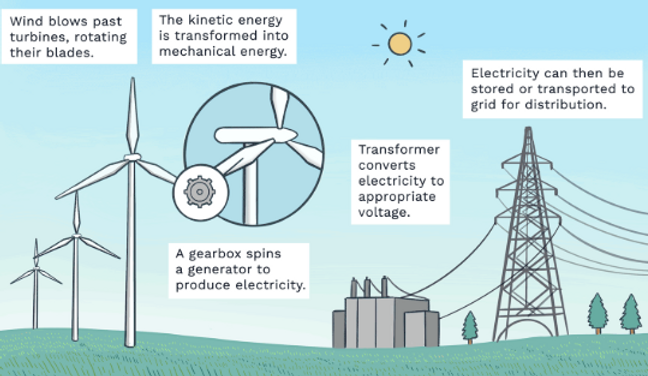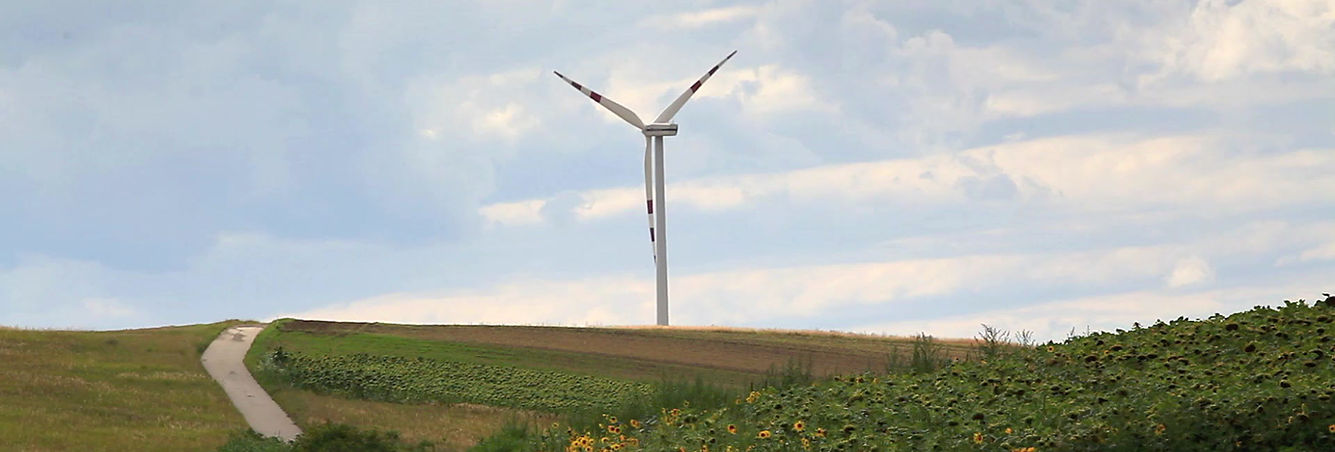
Video: How do Wind Turbines Work? ((For Grades 4-8th)
Let’s Go Deeper — The Science Behind the Spin (8–10th Grade):
Wind turbines are energy converters. They take one form of energy and transform it into another—using physics in action.
When wind hits the blades, it creates lift, making them spin—just like airplane wings. This rotation turns a shaft inside the nacelle (the box on top of the tower).
It all starts with kinetic energy: the energy of moving air. When wind pushes against the blades, their curved shape creates lift, just like airplane wings. This lift causes the blades to spin, which turns a shaft inside the nacelle (the box at the top of the tower).
The spinning shaft powers a generator, where mechanical energy becomes electrical energy through a process called electromagnetic induction—a discovery made by scientist Michael Faraday. As a magnet spins inside coils of copper wire, the changing magnetic field causes electrons to move through the wire. That movement creates an electric current.
The result? Clean electricity — enough to power everything from phones to entire cities. And unlike coal plants or large hydro dams, wind turbines generate energy with no fuel, no smoke, and no pollution—just motion, magnetism, and air.
In short, wind turbines are energy transformers:
Kinetic Energy (moving wind)
💨 → Mechanical Energy (spinning blades and shaft)
⚙️ → Electrical Energy (inside the generator)

How Does Wind Energy Work? Credit: Treehugger / Hilary Allison
Types of Wind Energy
Wind energy isn’t one-size-fits-all. It comes in different forms depending on how much power is needed and where it's being used.
Utility-Scale Wind
Large wind farms with powerful turbines (over 100 kW each) generate electricity for the main power grid—just like traditional power plants (coal or natural gas plants). As of 2022, wind power accounted for about 10.3% of total U.S. utility-scale electricity generation*.
Offshore Wind
Offshore turbines are built in oceans or large lakes near coastlines, where wind speeds are stronger and more consistent. The U.S. has over 2,000 gigawatts of offshore wind potential—nearly double the electricity currently used across the country**.
Small-Scale or Distributed Wind
These smaller turbines (typically 5–20 kilowatts) are used to power homes, schools, farms, or small businesses. Some are connected to the grid, while others work off-grid—often alongside solar panels or battery storage systems***.
From ocean turbines to backyard setups, wind energy comes in many forms—but it all starts with moving air and smart design.
Redesign the Future: Why This Matters—and Why You Matter
Wind power isn’t just about turbines—it’s about rethinking how we power the world.
Right now, wind turbines are helping replace fossil fuels—but that’s only the beginning. To truly solve the climate crisis, we need to go further. We need to design wind systems that are smarter, smaller, stronger, and everywhere.
But here’s the big idea:
Even the best technology only works if we make it affordable, scalable, and accessible.
But innovation doesn’t happen automatically.
It starts with a question—and someone bold enough to ask it.
That’s where you come in.
The future of wind power depends on creative thinkers and bold problem-solvers—people who can imagine new kinds of turbines, better materials, smarter storage, and fairer systems that bring clean energy to everyone.

Think like a climate designer.
Start with empathy. Zoom out. Look at the full system.Then ask questions that push the edge of what’s possible like:
-
What if buildings were made of turbine materials—so every wall could spin and generate power?
-
What if we could 3D-print floating wind farms in space and beam the energy back to Earth?
-
What if small wind turbines could be embedded in clothing to charge your devices as you walk?
-
What if a city’s traffic system redirected wind from moving vehicles to generate power in real time?
-
What if abandoned skyscrapers became vertical wind farms that powered the neighborhoods around them?
These aren’t just wild ideas.
They’re prompts for the world we need to build—and someone, someday, will bring them to life.
What if you could design the next great energy revolution—starting with the wind?
What if we got this right?


